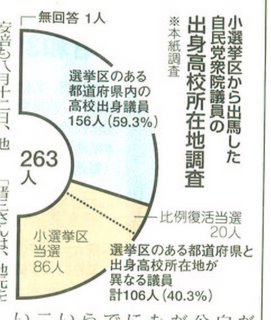It turns out that Bruce Wallace of the LA Times had dropped an article on exactly the same subject on his editor's desk 10 days earlier.
The paper did not run the story until this past Sunday.
Bad editor! Run Mr. Wallace's stories immediately in the future!
In the same vein (and on the same day) the Tokyo Shimbun published an article on a subject Okumura Jun of GlobalTalk 21 and I (of Shisaku, I guess) have both been carping on for a while: the increasing prominence of legacy LDP leaders (including all the candidates for the LDP party presidency this time around) who were neither born in nor attended schools in the districts they represent.
Take Abe Shinzō, for example. His local support group lauds him as the ninth prime minister from the former han of Chōshū, "the cradle of prime ministers". Except, of course, from nursery school to the day he left college, Abe was enrolled in Seikei Gakuen/Daigaku in Kichijōji. Abe took to calling himself a "man of Chōshū" only when he ran for his father's seat in the Diet.
On Sunday, the Tokyo Shimbun printed the following graphic:
 Of the 263 LDP district Representatives or LDP district candidates who lost in the district elections but "rose from the dead" thanks to the party lists for at-large seats, 59.3% attended high school in the district they represent or ran in and 40.3% did not (one stubborn old cuss would not reveal where he/she attended high school).
Of the 263 LDP district Representatives or LDP district candidates who lost in the district elections but "rose from the dead" thanks to the party lists for at-large seats, 59.3% attended high school in the district they represent or ran in and 40.3% did not (one stubborn old cuss would not reveal where he/she attended high school).Now for a society in motion like Japan was in the 1960s and 70s, with mass migration underway to the urban centers, a 60-40 split is not unreasonable. However, for a party that purports to be conservative and even traditionalist, having 40% of its members without furusato memories to call upon is a bit rich.
No comments:
Post a Comment